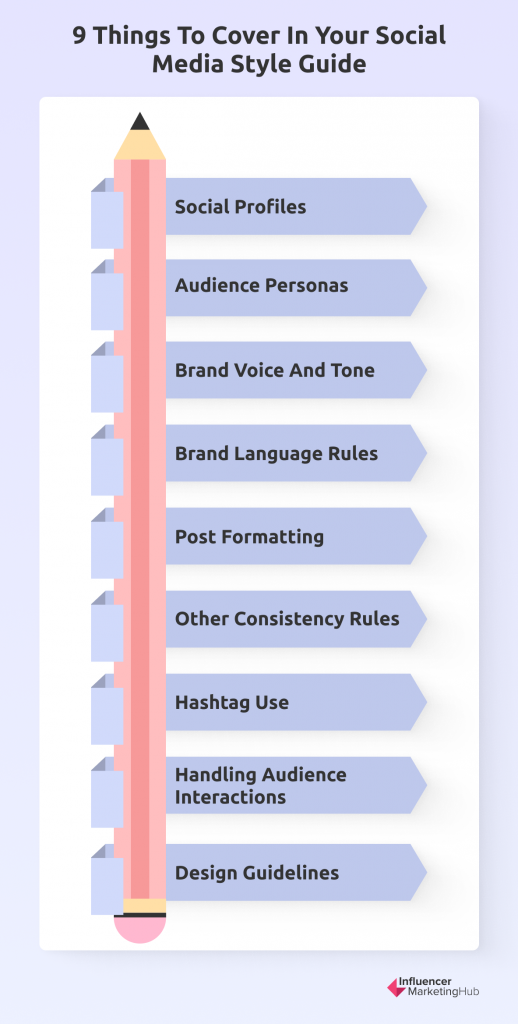Whether you’re a brand or creator, maintaining a consistent social media image is crucial to build a strong brand. Look at the explosive success of brands like Chipotle and Wendy’s with their fun, creative, and often snarky posts. Or how Denny’s has managed to amass hundreds of thousands of followers with their bizarre Instagram posts.
While the specifics may vary, there’s one key factor contributing to the success of these brands on social media–maintaining a consistent brand image. That’s where a social media style guide comes in, providing you with guidelines on what your brand voice should be, how your social media should look, and more. Let’s find out what a social media style guide is, why you need it, and what you should include when creating one.
The Complete Guide to Social Media Style Guides:
What is a Social Media Style Guide?
As the name suggests, a social media style guide is a set of guidelines on how your brand should look and behave across different social media channels. It informs how you present your brand on social media, which will then shape the way people perceive your brand. Essentially, it specifies what people should think about your brand and what kind of image they should associate with it.
Why Do You Need a Style Guide for Social Media?
A social media style guide is essential in the seamless execution of your social media strategy. It gives you a breakdown of how you should represent your brand on social media by outlining how your content should look and feel when you share it. Moreover, it also gives you directions on how to communicate with your audience, what brand voice you should maintain, and what type of language you should use.
For example, Innocent Drinks uses a social media brand voice that’s informal, direct, and almost naïve because it’s so simple. This perfectly represents the brand by exuding an air of innocence, aligning with the brand name.
#DidYouKnow that it isn't innocent company policy to expense flights to Crete just to photograph some product posts for our Inner Winner drink?
We definitely knew that already which is why we took these carefully edited photographs from our desk which is very much not in Crete. pic.twitter.com/icGGv85BOi
— innocent drinks (@innocent) August 4, 2022
As such, having a social media style guide allows you to maintain branding consistency across different social media channels, which will add to your credibility. This makes it particularly important for your multi-channel social media strategy as well. It provides your social media team with a solid understanding of the brand image and voice they need to use regardless of the platform.
So, even when onboarding new employees, they can get an instant feel of what’s expected of them. With the rules clearly laid out, they can quickly understand how you want the brand to be represented on social media. This also leaves less room for error as everyone involved in your social media knows how to execute your strategy in a way that aligns with your brand identity.
Additionally, a social media style guide is crucial if you’re outsourcing some of your creative and social media management tasks to freelancers or agencies. With all your branding guidelines organized into one useful guide, it becomes a go-to source for understanding your brand personality and image even for non-in-house talent. Similarly, it even helps with your influencer marketing strategy as it provides creators with some structure to follow when developing content for your campaign.
9 Things to Cover in Your Social Media Style Guide.
Social media style guides will look different for every company, and the components may not always be the same. That said, here are some of the key components to include in your social media style guide.
1. Social profiles
First things first, clearly list out all the social media profiles that your brand owns. You may use multiple social media channels and have multiple accounts on each platform. For example, brands like Netflix maintain a separate Twitter account just for customer support. Make sure those are all included in your list so you can get a complete view of your naming conventions.
One key area where you need to maintain consistency is in your naming conventions so people can easily recognize your brand no matter which new platform you decide to join. This will also help your audience differentiate between authentic profiles and fake profiles so they can decide which ones to trust.
Set clear guidelines on how to format your usernames across different social media channels. For example, Ben & Jerry’s doesn’t use the “&” symbol in their social media usernames, although it’s a part of the brand name. The brand spells it out and uses @benandjerrys across their social media profiles. For their subsidiary accounts in other countries, they add abbreviations of the region such as “UK” or “Oz” instead of “Australia.”
Make sure you also have a backup plan in case the exact username you want is unavailable. For example, you may need to add something like “official” or “HQ” to indicate which one’s your main brand account.
2. Audience personas
To develop an impactful brand voice, you need to know whom you’re speaking to. This makes it crucial to clearly define who your audience is and identify the different personas you want to target.
Your social media style guide should have brief descriptions of each persona so your team can quickly refer to this when developing content. Moreover, having your audience personas outlined will also give you a better sense of direction for the rest of your brand guidelines. For example, you’ll be able to develop a visual strategy that would appeal to your audience.
3. Brand voice and tone
Your brand voice is what sets you apart from the competition and helps you connect with your audience. Maintaining it consistently across your social media accounts is essential to build familiarity with your followers. You don’t want to send mixed messages by being all fun and quirky on Instagram but completely serious and unapproachable on Facebook.
While it’s true that you have to make slight adjustments in your voice based on the social media platform, try to keep your brand personality and essence intact. This would require finding the right balance between the voice that the platform’s audience prefers and the voice that’s true to your brand. Your social presence should still look and feel like you no matter which platform you’re using.
For example, LinkedIn is a social network where people maintain a professional tone of voice because of the professional nature of the platform. So, your first instinct may be to completely switch from a fun and quirky tone to a formal tone. Instead, try to maintain the right balance by keeping things casual and lighthearted without sounding completely unprofessional. That means limiting the snark and the sarcasm (if they’re synonymous with your brand voice) to Twitter or other, less formal platforms.
Everyone knows Wendy’s as a brand that doesn’t hold back on sarcasm and snark, with a strong “roasting” game on Twitter. But the brand keeps it slightly more professional on LinkedIn. For instance, in the following post introducing their new homestyle French toast sticks on the platform, the brand keeps it professional without sounding overtly formal and unapproachable. You can still get a sense of the brand’s fun and good-humored personality.
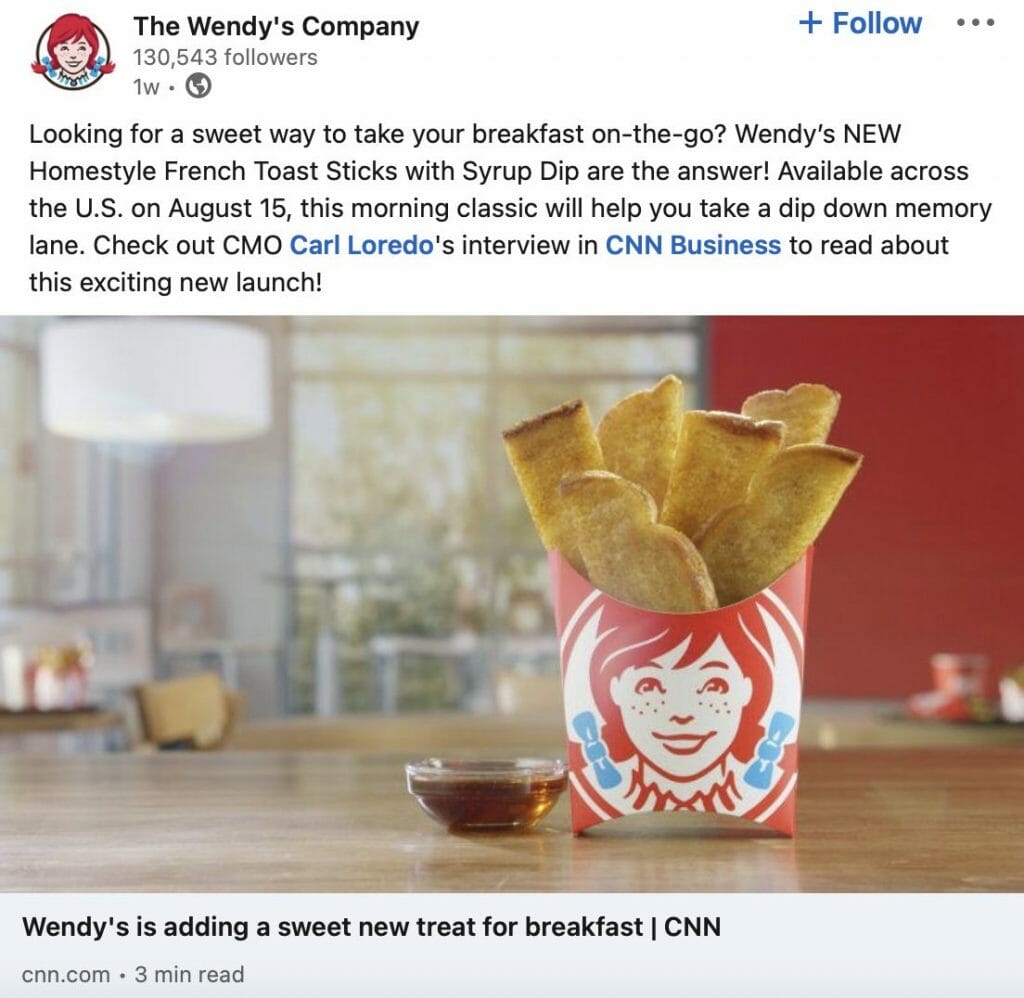
Source: linkedin.com
Be descriptive when defining your brand voice in your social media style guide. This will help you set clear expectations with your social media team about what your brand should sound like. Autodesk even helps people to visualize their brand voice by creating a graph illustrating the right balance they’re looking for. To further clarify your expectations, try to provide different examples of what’s bad and what’s good.
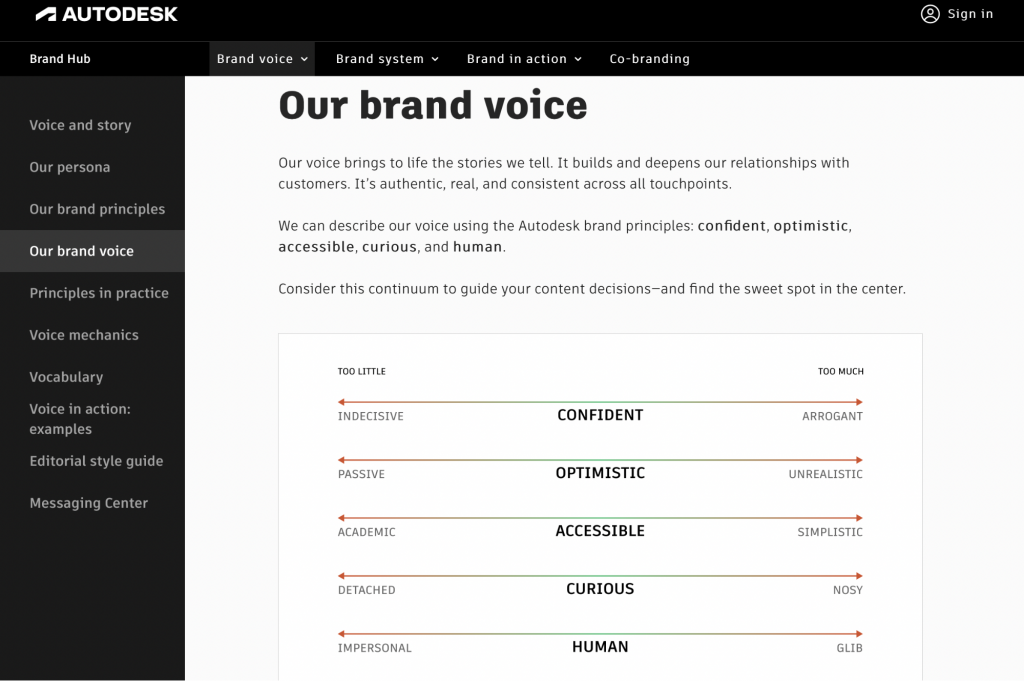
Source: brand.autodesk.com
Additionally, you should also specify other details such as:
- Whether to use jargon and which words to avoid
- How to keep your voice inclusive
- Whether to use emojis, stickers, and GIFs, which ones are acceptable, and on which platforms
- How and where to include calls-to-action
One key detail to include is when to make exceptions. When is it okay to deviate from your brand voice? For example, if you’re posting your condolences about some calamity, it might not be the best idea to maintain the usual sense of humor that’s synonymous with your brand on social media.
When floods hit Eastern Kentucky, Denny’s immediately switched from their usual lighthearted brand voice and replaced their bizarre Instagram posts with a serious message. The brand offered help and provided details on where people can get help.
4. Brand language rules
Consistency is about keeping things on-brand, and your social media style guide should outline the specifics of brand-specific language. This includes details such as trademarks–whether to capitalize brand names and product names. For example, thredUP chooses to only capitalize “UP” and avoids starting their brand name with a capital letter. You can see this being used consistently across the brand’s social media accounts as well.
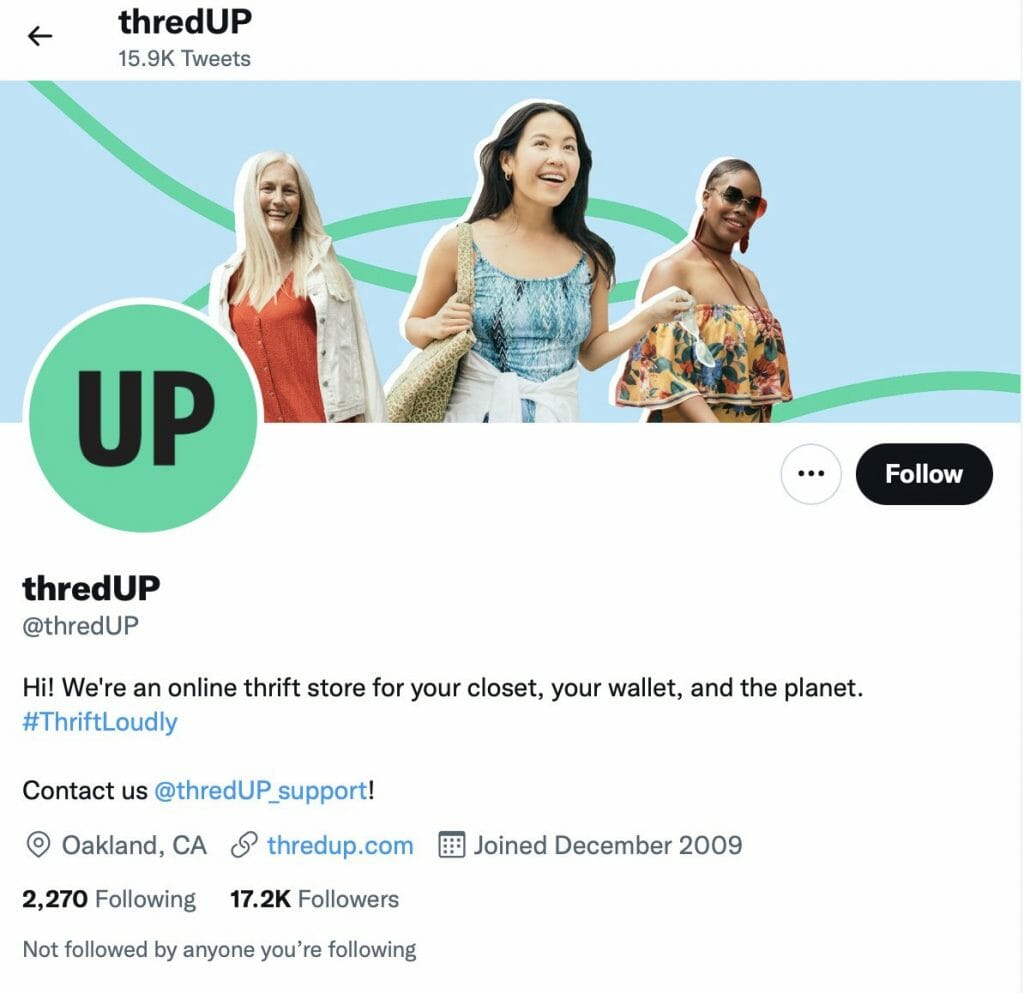
Source: twitter.com
Additionally, you should make a list of other brand-specific language and acronyms. For example, BUXOM Cosmetics uses the term “BUXOM babe” to refer to fans on social media. They use this term as a hashtag when sharing user-generated content.
5. Post formatting
Do you want to follow a specific format for your posts? For example, you might want to include line breaks between posts with longer captions. Or perhaps when sharing link posts, you might want to precede the link with a brief caption and follow it up with a hashtag or two. Alternatively, you might want to include all your hashtags in the first comment.
In addition, you might want to attribute your support-related responses by including a signature to let customers know whom they’re talking to. Specifying these formatting rules will give your team a better sense of direction for creating your social media content.
6. Other consistency rules
Besides the above, you should also consider specifying the different linguistic and style rules to follow to maintain consistency. This may include whether to use U.K or U.S English depending on your location and target audience. Besides this, you could also choose which existing style guides to use–Chicago Manual or Associated Press.
Other minor consistency rules may include:
- Whether to shorten your URLs
- How to format dates and times
- Which dash style to use
- Whether to use the Oxford comma
- Whether to use sentence case or title case for headlines
7. Hashtag use
One of the most important parts of your social media style guide is the hashtag-related rules. Since hashtags play such a crucial role in boosting visibility and impact on social media, you need to establish a strong hashtag strategy and follow it consistently. More importantly, you should also outline this hashtag strategy in your social media style guide so everyone in your team can help you execute it.
Don’t hesitate to go in-depth into this section of your style guide. Make sure the following specifics are clearly included.
Which hashtags to use
What are the branded hashtags that you plan on using? How often should they be used, and which types of posts should have them? For example, you may want to include product-name hashtags in product promotion posts. Or like Gisou, you could also include other branded hashtags such as #beepoweredhaircare and #beepoweredglow, which aren’t exactly product names but are specific to the brand.
Are there any hashtags specific to your campaigns? Perhaps you have hashtags to use consistently for your ongoing campaigns? Or a hashtag that you should only use for a specific period while the campaign lasts.
Additionally, do you plan on using trending and generic hashtags relevant to your content? If so, how often should you use them and how do you plan on finding popular hashtags? Make sure to specify all of these details so there’s no confusion about when to use hashtags and which hashtags you should use.
Number of hashtags
Another important detail to include is the number of hashtags to include in your posts. Some brands like to load up their posts with a bunch of hashtags, while others try to keep it minimal with just a couple of hashtags here and there. For example, Pedro Garcia Shoes only includes two hashtags consistently throughout their Instagram posts.
Formatting hashtags
Be sure to specify whether to use lowercase or uppercase in your hashtags, as well as which letters to capitalize. While this doesn’t make that big of a difference technically, it could improve your hashtag readability and make it more visually appealing. For example, #SheHulk is far easier to read and understand than #shehulk. But #madeinspain may be more stylistically appealing than #MadeInSpain.
8. Handling audience interactions
Next, it’s time to set up rules on how to respond to your audience. Will you simply thank them for a positive brand mention or ask them a follow-up question? Or will you try to resolve issues in public comments or take it to the inbox?
Make sure everyone’s on the same page by creating a formal guideline on how to handle different types of audience interactions. Ideally, you should put together a bunch of predetermined on-brand replies that your team can customize and reuse for common situations.
While this can save you time and maintain branding consistency, try not to overdo it. You don’t want to sound robotic by responding to each and every customer with the same message. Find ways to keep your responses human and personal. See how Canva keeps their responses varied and personalized to each user in the following examples.
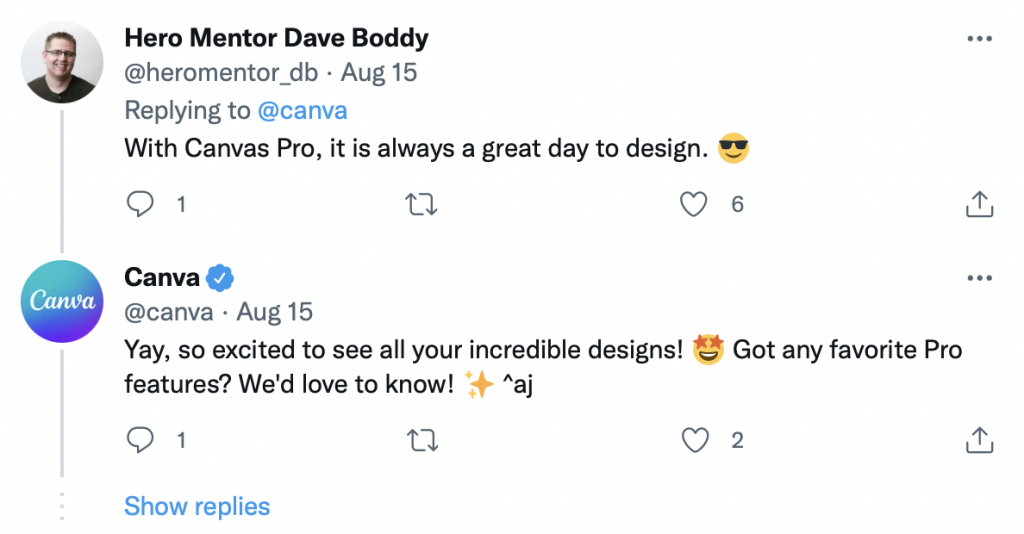
Source: twitter.com
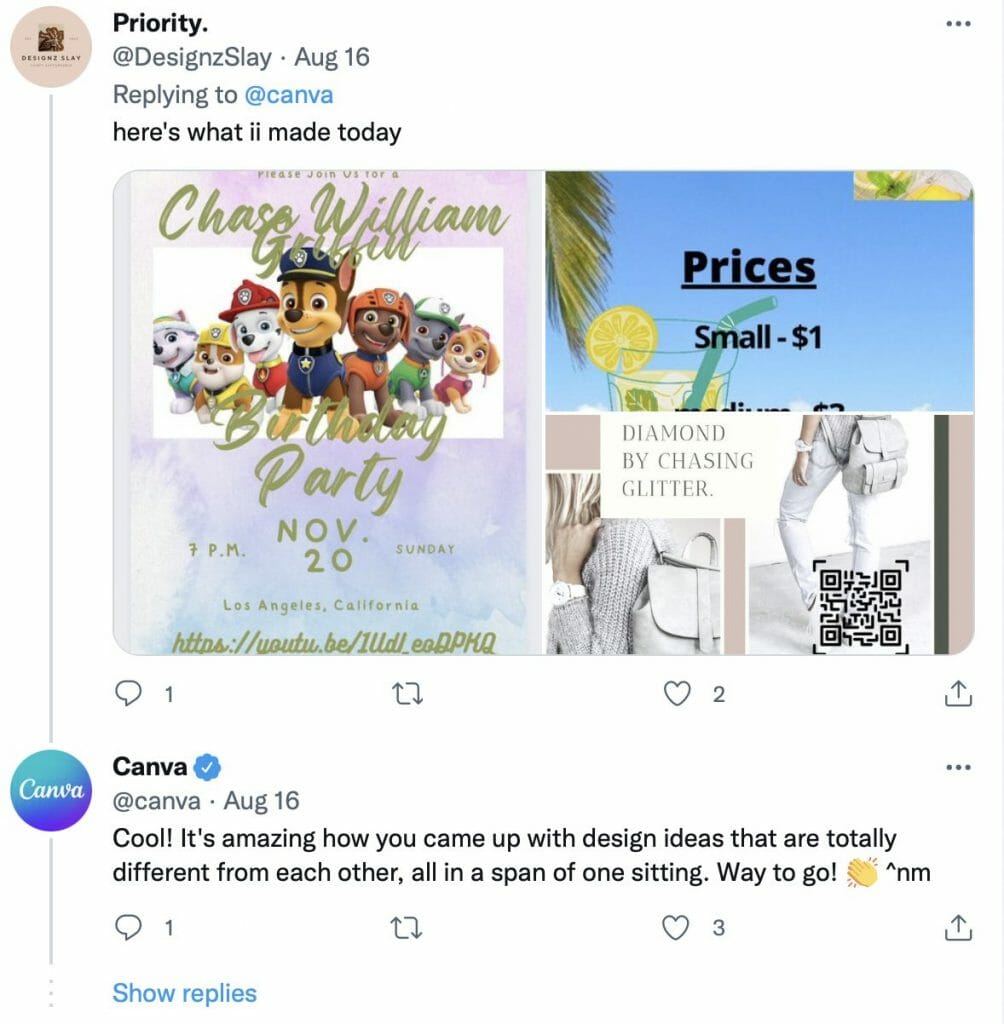
Source: twitter.com
9. Design guidelines
With social media being a highly visual channel, odds are that you’ll share some original graphics every once in a while. Make sure your style guide clearly specifies the guidelines for design so your brand’s visual look and feel remain consistent.
Your design guidelines should clearly outline which color palette to use and which fonts to use. Depending on the application, you may also need to choose multiple fonts that can be used consistently across different designs.
Moreover, be sure to clarify which filters and effects are on-brand. Describe the overall look and feel you want to exude through your images so that your team can maintain it consistently.
You might also want to specify when and where to use your logo. Some brands might need to create a modified version of their logo just for social media use. For instance, you’ll need to crop your logo into a circular shape to fit the profile picture specs of some social media channels.
For Instagram specifically, make sure to define the grid layout you want to maintain. If you want to maintain a coherent feed with a consistent look and feel, it’s important to clearly outline what your grid should look like. Give examples of how to organize your posts to achieve this goal.
Strengthening Your Brand Identity on Social
A solid social media style guide is the key to achieving branding consistency on social, which will subsequently help you establish a strong brand identity. Use the tips shared above to create or improve your brand’s social media style guide.
Frequently Asked Questions
How do I create a social media style guide for my brand?
You can create a brand social media style guide by defining your brand voice, developing creative guidelines for content, and establishing language and consistency rules to follow.
What is a style guide for Instagram?
A style guide for Instagram is a set of rules to follow when developing content for Instagram.
Why do you need a style guide?
A style guide helps you maintain consistency and improve your brand credibility, which will also contribute to a stronger brand image.
What does a brand style guide look like?
A brand style guide looks like a rulebook that specifies how to present your brand to the world. It may include guidelines for design, language, voice, color selections, and more.
What should a style guide include?
Your social media style guide should include specifications for brand voice and tone, language, post formatting, design, hashtag use, and handling audience interactions.
